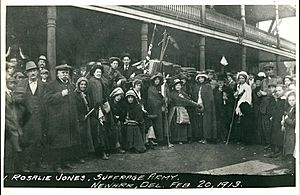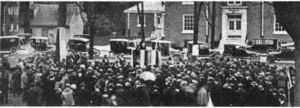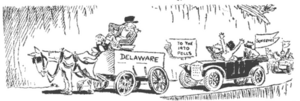Timeline of women's suffrage in Delaware facts for kids
This is a timeline of how women in Delaware fought for the right to vote. People who supported women's voting rights, called suffragists, started their efforts in Delaware in the late 1860s. Important leaders like Mary Ann Sorden Stuart and other national suffragists worked hard to convince the Delaware General Assembly (Delaware's state legislature) to allow women to vote.
In 1896, a group called the Delaware Equal Suffrage Association (DESA) was created. They held yearly meetings across the state. Many times, they tried to add an amendment (a change) to the Delaware State Constitution that would give women the right to vote, but these attempts were not successful.
In 1913, a state branch of the Congressional Union (CU) was started by Mabel Vernon. Delaware suffragists also took part in more direct actions, like joining the Silent Sentinels. These women stood silently outside the White House to protest. On March 22, 1920, Delaware's General Assembly met in a special session to decide if they would approve the Nineteenth Amendment. This amendment would give women across the United States the right to vote. Delaware did not officially approve it until 1923.
Contents
Early Efforts for Women's Vote (1800s)
The 1860s: Starting the Fight
1869
- November 12: A meeting about women's rights happened in Wilmington, Delaware. The Delaware Suffrage Association was formed. This group joined forces with a national organization called the American Woman Suffrage Association (AWSA).
The 1870s: Speaking Up
1878
- Mary Ann Sorden Stuart spoke to the United States Senate Judiciary Committee. She argued strongly for women's right to vote.
The 1880s: Gaining Support
1881
- Mary Ann Sorden Stuart, along with famous suffragists Susan B. Anthony and Elizabeth Cady Stanton, tried to convince the Delaware General Assembly to change the state constitution to allow women to vote.
1888
- The Delaware branch of the Women's Christian Temperance Union (WCTU) supported women's suffrage. This group worked to stop alcohol use and also believed women should vote.
- The Delaware WCTU created a "franchise department" to focus on voting rights.
The 1890s: New Groups and Conventions
1895
- June: Mary Church Terrell, an important civil rights and women's rights activist, spoke at the graduation ceremony for Howard High School.
- November 18: The Wilmington Suffrage Club (or Association) was formed.
1896
- January 17–18: The first yearly state suffrage meeting was held in Wilmington. The Delaware Equal Suffrage Association (DESA) was officially created. It became part of the National American Women's Suffrage Association (NAWSA).
- November 27: The second yearly state suffrage meeting took place in Wilmington.
1897
- January 13: Well-known suffragists spoke at a meeting for the Delaware constitutional convention. They asked for women's voting rights to be included in the new state constitution.
- February 16: A vote was held on a proposal to remove the word "male" from the description of a voter in the state constitution. This proposal did not pass.
- April 22–23: A national suffrage meeting was held in Wilmington.
- December 2: The third yearly state suffrage meeting was held in Delaware.
1899
- December 15: A state suffrage meeting was held at the Wilmington Unitarian Church. Carrie Chapman Catt, a national suffrage leader, was the main speaker.
The Fight Continues (1900s)

The Early 1900s: Regular Meetings
1900
- Some women who paid property taxes were allowed to vote for school commissioners in Delaware. This was a small step forward.
- November 15: A state suffrage meeting was held in New Castle, Delaware.
1901
- November 6: The state suffrage meeting took place in Newport, Delaware.
1902
- November 8: The state suffrage meeting was held in Wilmington.
1903
- November 28: The state suffrage meeting was held in Newport.
1904
- November 22: The state suffrage meeting was held in Wilmington.
1905
- November 4: The state suffrage meeting took place in New Castle.
1906
- November 6: The state suffrage meeting was held in Newport.
1907
- October 2: The state suffrage meeting was held in Wilmington.
1908
- November 12: The state suffrage meeting was held in Newport.
1909
- The DESA helped NAWSA gather signatures for a petition to support a federal amendment for women's suffrage.
- November 29: The state suffrage meeting was held in Wilmington.
The 1910s: Marches and Protests
1910
- November 10: The state suffrage meeting was held in Wilmington.
1911
- November 9: The yearly state suffrage meeting was held in Newport.
1912
- November 20: The state suffrage meeting was held in Wilmington.
- The Arden Colony formed its own women's suffrage group.
1913
- An amendment to the Delaware constitution for equal suffrage did not pass in the General Assembly.
- January 4: Suffragists in Wilmington spoke to the Charter Commission. They asked for women to be able to vote in city elections, but this was not approved.
- February 18–20: The Wilmington suffrage group hosted Rosalie Gardiner Jones and her "suffrage pilgrims." These women marched long distances to promote voting rights.
- March 3: Delaware sent suffragists to the large Woman Suffrage Procession in Washington, D.C..
- April 7: Delaware suffragists joined a march to the Capitol. They carried letters for the U.S. Congress.
- Summer: Mabel Vernon was hired to organize the Delaware chapter of the Congressional Union (CU).
- September: The CU and DESA opened a shared headquarters for women's suffrage in Wilmington.
- November 6: The state suffrage meeting was held in Wilmington.
1914
- May 2: A large parade for women's suffrage took place in Wilmington.
- May 9: Delaware was represented in a national suffrage parade in Washington, D.C.
- Summer: Florence Bayard Hilles and Elsie Hill went on a two-day tour. They visited 7 Delaware towns to promote suffrage.
- October 30: The yearly state suffrage meeting took place in Dover.
1915
- Hilles drove her car, called the "Votes for Women Flyer," across Delaware.
- February–March: Blanche Williams Stubbs and Mary J. Johnson Woodlen wrote articles in Wilmington newspapers. They discussed the issue of racism against Black women's suffrage.
- March: Another equal suffrage amendment failed in the General Assembly.
- June: The DESA moved out of the shared headquarters after they disagreed with the CU.
- November 11: The yearly state suffrage meeting was held in Wilmington.
1916
- July 8: Mary Ospina of DESA asked members of the Delaware General Assembly about their views on women's suffrage.
- November 10: The state suffrage meeting was held in Wilmington.
1917
- January: Governor John G. Townsend, Jr. announced his support for women's suffrage.
- February: A full bill to grant equal suffrage was defeated in the General Assembly.
- March 1: This was "Delaware Day" for the Silent Sentinels. All the women picketing (protesting) outside the White House on this day were from Delaware.
- November 22: The state suffrage meeting was held in Newport.
- November 23: The DESA officially stated that the group was against picketing.
1918
- May: A campaign to gather signatures for a women's suffrage petition was launched. The petition was to be sent to Congress from the Hotel DuPont in Wilmington.
- November 29: The state suffrage meeting was held in Wilmington.
1919
- January: Maria McMahon came to Delaware to open a suffrage headquarters in Dover.
- February: Suffragists sent about 600 telegrams to their U.S. Senators. They asked them to support the federal amendment for women's suffrage.
- June 26: The DESA celebrated when Congress approved a federal suffrage amendment.
- August 3: The National Women's Party (NWP) held a rally in Wilmington to encourage ratification (approval) of the amendment.
- August 9: Dover, Delaware held its own ratification rally.
- November: The state suffrage meeting took place in Dover.
The 1920s: The Final Push
1920
- March 22: A special meeting of the Delaware General Assembly was called.
- March 25: A hearing about women's suffrage took place in the General Assembly.
- April 5: Emma Belle Gibson Sykes wrote an article in the Sunday Star. She spoke out against racist opposition to women's suffrage.
- April 20: A large suffrage rally was held in Dover.
- May 5: The General Assembly Senate approved the federal suffrage amendment.
- May 28: The General Assembly House voted against the federal suffrage amendment.
- June 2: The Delaware General Assembly ended its session. They did not ratify the 19th Amendment at this time.
1923
- Delaware finally ratified (approved) the 19th Amendment. This happened several years after it became law for the rest of the country.





